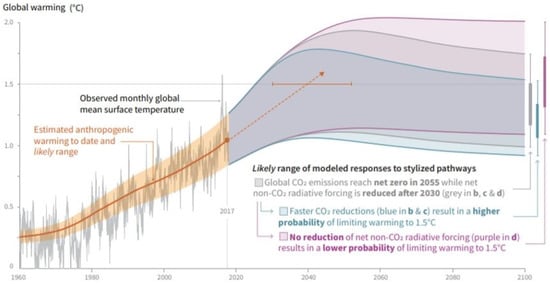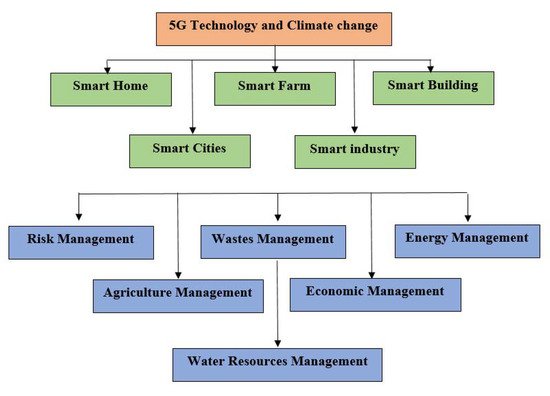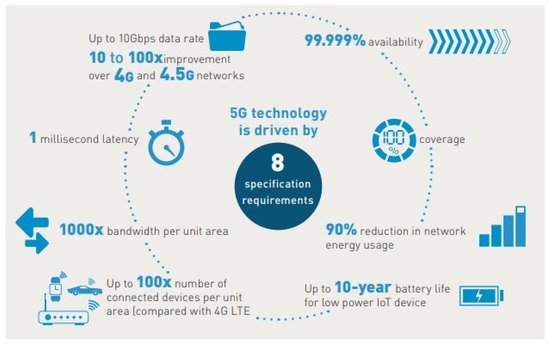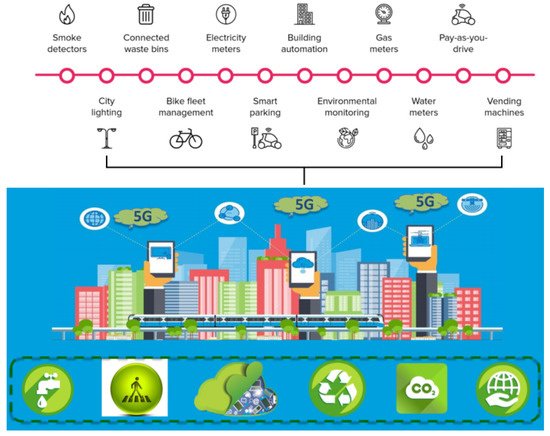You're using an outdated browser. Please upgrade to a modern browser for the best experience.

Submitted Successfully!
Thank you for your contribution! You can also upload a video entry or images related to this topic.
For video creation, please contact our Academic Video Service.
| Version | Summary | Created by | Modification | Content Size | Created at | Operation |
|---|---|---|---|---|---|---|
| 1 | Ghasan Huseien | + 2726 word(s) | 2726 | 2021-09-09 07:56:31 | | | |
| 2 | Rita Xu | Meta information modification | 2726 | 2021-09-13 08:24:26 | | |
Video Upload Options
We provide professional Academic Video Service to translate complex research into visually appealing presentations. Would you like to try it?
Cite
If you have any further questions, please contact Encyclopedia Editorial Office.
Huseien, G. 5G for Climate Change Control. Encyclopedia. Available online: https://encyclopedia.pub/entry/14114 (accessed on 02 January 2026).
Huseien G. 5G for Climate Change Control. Encyclopedia. Available at: https://encyclopedia.pub/entry/14114. Accessed January 02, 2026.
Huseien, Ghasan. "5G for Climate Change Control" Encyclopedia, https://encyclopedia.pub/entry/14114 (accessed January 02, 2026).
Huseien, G. (2021, September 12). 5G for Climate Change Control. In Encyclopedia. https://encyclopedia.pub/entry/14114
Huseien, Ghasan. "5G for Climate Change Control." Encyclopedia. Web. 12 September, 2021.
Copy Citation
Climate change is one of the most challenging problems that humanity has ever faced. With the rapid development in technology, a key feature of 5G networks is the increased level of connectivity between everyday objects, facilitated by faster internet speeds with smart facilities indicative of the forthcoming 5G-driven revolution in Internet of Things (IoT).
5G technology
climate change
energy management
smart cities
sustainability
wastes management
1. Introduction
Currently, the entire planet is at risk due to continual climate change [1][2][3]. The recorded increase in average temperature across the world in the past hundred years, and the associated changes attributed to this, are known as global warming. Many scientists are convinced by the published evidence that this change is anthropogenic and resulted from the elevated emission levels of global greenhouse gases (GHGs) [4][5]. Gases such as water vapor, carbon dioxide, methane, nitrous oxide, and ozone are responsible for the absorption and emission of thermal radiation. These changes in the relative quantities of the GHGs induce a proportional change in the amount of preserved solar energy. Presently, the accepted indicator for global warming is the sustained rise in the mean temperature worldwide. This definition is designed to account for the fact that there may be some localized exceptions to this rise. For example, there may be cooling experienced in a region while the global temperature may increase altogether, hence the need for average temperature. A key concern with the GHGs trapping of more heat in the atmosphere is that it affects both climate and short scale weather patterns. Consequently, it results in greater numbers of adverse weather events such as storms, heat waves, cold snaps, droughts, and fires [6]. Climate-related risks to health, livelihoods, food security, water supply, human safety, and economic growth are projected to increase with global warming of 1.5 °C [7] and further increase further at 2 °C, as shown in Figure 1. In addition, the risks to global aggregated economic growth due to the climate change impacts are projected to be lower at 1.5 °C than at 2 °C by the end of this century.

Figure 1. Recorded and expected global warming from 1960 to 2100 [7].
Carbon dioxide has the most substantial effect on global warming [8]. Although it was once assumed to have an ~100 year lifespan in the atmosphere, careful studies revealed that the situation is far worse, with three-quarters of the gas expected to remain for a time in the region of up to ~1000 years, with the remainder lasting for an indefinite period of time [9]. It was indicated that the present impacts of humanity on the atmosphere can certainly cause a long term problem [10]. Carbon dioxide is released when oil, coal, and other fossil fuels are burnt for the energy we use to power our homes, cars, and smartphones. By lessening its usage, we can curb our own contribution to climate change while saving money. The first challenge is eliminating the burning of coal, oil, and, eventually, natural gas. Oil is the lubricant of the global economy as it is hidden inside such ubiquitous items as plastic and corn, fundamental to the transportation of both consumers and goods. Coal is the substrate, supplying roughly half of the electricity worldwide, a percentage that is likely to grow according to the International Energy Agency (IEA). In fact, buildings contribute up to 43% of all the greenhouse gas emissions worldwide [11], even though investing in thicker insulation and other cost-effective as well as temperature-regulating strategies can save money in the long run. Investment in new infrastructures, or radical upgradation of the existing highways and transmission lines, may help to reduce greenhouse gas emissions, yielding economic growth in the developing countries.
Nations across the globe have kept very high targets to reducing their GHG discharges [12][13]. In order to meet these goals, considerable reductions in city energy usage is required. At a global scale, urban communities represent over half (55%) of the population, which is predicted to reach 68% by the middle of this century [14]. Urban areas claim ownership of the highest levels of energy use, gas emission, and also the largest local economy. As such, it is crucial for urban areas to reduce their consumption and utilize renewable sources wherever available to reduce their gas discharge levels. Smart cities often utilize digital sensors to measure and transmit data about the levels of GHGs in the city at that moment, as a means of tackling them [15]. The efficacy of such a system is thus reliant on the network used to collate and analyze the data collected as an extant network. The mobile telecommunications networks offer a convenient solution to this desire, as their pre-existence has the clear benefit of reducing costs compared to the design and implementation of a novel system. It is recognized that smart cities will certainly act as the key players meeting these ambitious targets [16][17]. In this study, we focused primarily on the potential applications of 5G network technology to control climate change in Singapore. In addition, a clear overview of the sustainability benefits of introducing 5G technology compatible smart cities, buildings, and farms in all aspects of urbanization is provided. Herein, the main purpose is to tackle the negative outcomes associated with anthropogenic climate change, with a particular focus on the contributions that are best made by the telecoms network operators.
Climate change is one of the most challenging problems that humanity has ever faced. Presently, hundreds of millions of lives, innumerable species, entire ecosystems, health, economy, and the future habitability of this planet are at risk. Fortunately, climate change is solvable, we just need to wisely exploit the existing technologies and sciences. Climate change mitigation is a pressing international need in which many management actions are required. The development of 5G technology has been largely driven by smart mobile devices and advanced communication technologies. It may thus serve as a technical enabler for a whole new range of business opportunities, energy, and facilities management, together with industrial applications. Moreover, it may enable different devices to work together seamlessly. Definitely, the 5G cellular network technology is expected to revolutionize the global industries with profound effects on the savings of energy, waste generation and recycling, and water resources management, thus reducing the climate change impacts.
Motivated by the requirement of the smart cities to control climate change and reduce their global greenhouse emission, this paper aimed to guide the stakeholders in the infrastructure and construction industry to adopt a better path with the proper use the 5G technology to address the climate change issues. In addition, it may inspire the researchers’ thinking in the technology industry for future advancement of Singapore through collaboration trends of different industries. This paper also analyzed how 5G networks can help to overcome the challenges posed by the current wireless networks in implementing smart energy, water resource, risk, economic, and waste management solutions. Figure 2 illustrates the potential applications of 5G technology to reduce greenhouse gas emissions and climate change impacts. It discusses climate change, the advantages of 5G networks, and the main drivers of smart management. First, various climate change risk factors and various benefits of 5G networks for smart management are explored. Finally, the paper is concluded followed by some recommendations for further research and development within this field.

Figure 2. Applications of 5G technology for reducing the climate change impacts.
2. Climate Change Risk Factors
Climate change has several implications for the environment and public health. It has been inferred that the rise in the sea level will adversely affect millions of lives [18]. Higher concentrations of carbon dioxide are due to the excessive use of fertilizers for increasing crop yields. In fact, increases in the number of chemicals used have considerable economic and environmental consequences, especially the water table beyond their natural state [19]. Problems related to pest and disease control in the agricultural settings can affect the moisture–temperature balance [20]. Generally, it is recognized that both temperature and an appropriate level of moisture can overcome such a problem. A rise in the global average temperature implies that equatorially confined problems are expected to be seen more regularly further to the north and south. In short, climate change is associated with the (i) variability of rainfall patterns; (ii) changes in water levels in the lakes, rivers, seas, ponds, streams, and groundwater; (iii) frequency of storms and droughts; (iv) increased desert encroachment; (v) excessive heat. In fact, all of these have serious implications on the environment and public health.
In the United States, a government report shows that the climate is constantly changing, wherein further human activities will lead to many more changes. These changes will affect the sea levels, drought frequency, severe precipitation, and so forth. The Climate Science Special Report was created by a United States government organization for coordinating and integrating the federal research data on the global environment changes and their implications for the society. It also laid out the current state of science relating to climate change and its physical effects [21]. This report has assimilated numerous data on the rise of surface water level; atmospheric and oceanic temperatures; melting glaciers; diminishing snow cover; shrinking sea ice; rising sea levels; ocean acidification; increasing intensity and frequency of rainfall, hurricanes, heat waves, wildfires, and drought. It meticulously outlined how these effects can largely be traced back to human activities and associated emissions of potential GHGs as well as particles. Underlying the report is a broad scientific consensus which indicated that the farther and faster the Earth system is pushed toward more changes, the greater the risk is of unanticipated effects wherein some of them are potentially large and irreversible. It is expected that drought may plague the western United States for decades to come as well as Atlantic and Pacific hurricanes that could be even more violent [22]. Briefly, the report showed that our current emission trajectories may bring our planet into a very different climate state than it is today, with profound effects on the United States.
In many regions of the European countries, extreme weather and climate-related hazards such as heat waves, floods, and droughts will become more frequent and intense. This will have adverse impacts on ecosystems, economic sectors, and human health. Therefore, the risks minimization due to global climate change requires various targeted actions for adapting to such climate change-related impacts in addition to the remedial measure to reduce the GHG emissions. Adaptation must be tailored to the specific circumstances in different regions and cities of Europe. Climate change affects the agricultural systems in complex ways. In fact, the increase in the atmospheric CO2 concentrations, temperatures, and changes in the precipitation patterns including the drought conditions can significantly affect the quantity, quality, and stability of food production. Although the food security in Europe is not expected to be at risk, the cascading impacts of climate change from outside Europe may further affect the agricultural income and price levels in Europe due to the alterations of trade patterns [23].
Climate change has already affected the conditions in Singapore with a mean temperature rise from 26.6 °C to 27.7 °C during 1972–2014 [24]. Sea levels have also shown annual increases of 1.2–1.7 mm in an equal timeframe (1975–2009). Increased annual rainfall has lately became a grave concern, wherein a rise from 2192 mm to 2727 mm across the span 1980–2014 has been observed. The north of Singapore in 2001 witnessed the impact of the first ever equatorial typhoon, Vamei, causing widespread localized flooding. The opinions about this typhoon are divided on the likelihood of repetition. The low altitude nature of the city state ensures that rising sea levels present the greatest threat to its future, with 30% of the city lying less than 5 m from the waterline and much of the rest within 15 m. More frequent changes in the local weather patterns can also hamper efforts of supplying potable water, as both droughts and excess rainfall are liable to either empty or overwhelm the current systems. It is also recognized that an average temperature rise in the range of 1.5–2.5 °C may be likely to have a significant negative impact on the biodiversity of both flora and fauna, endangering multiple species and potentially damaging the ecosystem’s ability to counter the effects of climate change. The location of Singapore is firmly within the region where vector-borne diseases are locally prevalent during the warm season, which may happen concurrently with heat related afflictions in the elderly and infirm. In addition, it is found that urbanization increased the local temperatures due to its ability to produce and store heat in buildings and infrastructures. Consequently, a demand for a higher prevalence of cooling technologies such as air-conditioning units and associated energy burdens is likely, thereby increasing the release of GHGs. At a wider scale, since Singapore is reliant on global imports for the vast majority (>90%) of its food provision, distant climate change effects on the food production may still have a knock-on effect.
3. Benefits of 5G Technology Applications against Climate Change-Related Risk Factors
The latest version of the digital telecom technology called 5G networks was released to the general public in 2018 and, since then, it has seen global implementation. Although it primarily aimed to provide higher rates of data transmission, the emergent network is rapidly becoming the tool of choice for the inter-communication needed within the greater IoT ecosystem because it offers appropriate cost, delay, and speed. Figure 3 depicts the eight key requirements of 5G network technology [25]. A key feature of 5G technology is the increased level of connectivity between everyday objects, facilitated by faster internet speeds with smart facilities indicative of the forthcoming 5G driven revolution in IoT. This technology offers impressive levels of robust and dispersible connectivity across the entire globe wherein the key design features such as low latency and high transmission rates [26] ensure the possibility of instantaneous processing between multiple locations. In brief, this allows the implementation of new ideas that were not previously possible with its predecessors. At present, the concept of IoT is well known [27], describing the smart devices that are restrained to perform a specific or limited subset of tasks compared to a general device such as a smartphone or computer. Easily recognizable examples of IoT in practice include security cameras, central heating controllers, and white goods.

Figure 3. Specification requirements of 5G technology [25].
Today’s smart city is an enabling platform that delivers advanced services for its businesses and residents, providing a better quality of life for all [28]. Network infrastructure is critical for realizing this potential. Defined by its high-speed, low-latency data transmission, and ubiquitous connectivity, a well-planned infrastructure transforms the cities into vibrant socio-economic communities. The Internet of things (IoT) is utilized as a part of the smart city through instantly collating data that can be used to rapidly and cheaply adapt the public systems in response to demand fluctuations. The ecosystem of a digital city is one that operates through the interplay of multiple congruent networks, each serving as a distinct element of the conurbation, such as mobile devices, cars, white good, sensors, or communication gateways. Current estimates of IoT take-up suggest that 5G technology will be responsible for 75 billion interconnected devices by the end of 2025. These devices are expected to generate enormous data that can be used by the public sectors to guide their policy developments in a way that offers the best results for participants. This system is generally termed as “Massive IoT” infrastructures. In addition, 5G technology will usher in a new era of smart energy management, smart houses, smart farms, smart buildings, and much more (Figure 4) [29]. Therefore, 5G cellular networks will be more densely connected and will be the main catalyst for IoT innovation and technologies, contributing to more sustainable cities.

Figure 4. Effect of 5G technology on sustainability of cities and climate change control [29].
The creation of smart cities strongly depends on the increased use of 5G networks, with the cities around the globe racing to improve all aspects of their governed realms through the social, monetary, and environmental gains offered by this technology. Furthermore, 5G network offers the basis for the next generation of technology to be built upon. The reasons why 5G is appropriate for the smart solutions to city management are primarily due to its enormous computing capacity and extent of connectivity. The use of new technology can be highly effective to improve energy, waste, water resource, traffic flow, and parking management. The end result is that a house, farm, factory, building, and city can be more efficient, termed as smart management. Overall, it may greatly reduce carbon dioxide emissions and climate change problems.
References
- De Coninck, H.C. IPCC SR15: Summary for Policymakers. In IPCC Special Report Global Warming of 1.5 °C; Intergovernmental Panel on Climate Change: Geneva, Switzerland, 2018.
- Cobacho, S.P.; Wanke, S.; Konstantinou, Z.; El Serafy, G. Impacts of shellfish reef management on the provision of ecosystem services resulting from climate change in the Dutch Wadden Sea. Mar. Policy 2020, 119, 104058.
- Shah, K.W.; Huseien, G.F. Biomimetic Self-Healing Cementitious Construction Materials for Smart Buildings. Biomimetics 2020, 5, 47.
- Huseien, G.F.; Mirza, J.; Ismail, M.; Ghoshal, S.K.; Hussein, A.A. Geopolymer mortars as sustainable repair material: A comprehensive review. Renew. Sustain. Energy Rev. 2017, 80, 54–74.
- Goldberg, M.H.; Gustafson, A.; van der Linden, S. Leveraging Social Science to Generate Lasting Engagement with Climate Change Solutions. One Earth 2020, 3, 314–324.
- Taillardat, P.; Thompson, B.S.; Garneau, M.; Trottier, K.; Friess, D.A. Climate change mitigation potential of wetlands and the cost-effectiveness of their restoration. Interface Focus 2020, 10, 20190129.
- Masson-Delmotte, V.; Zhai, P.; Pörtner, H.-O.; Roberts, D.; Skea, J.; Shukla, P.R. ShuklaGlobal warming of 1.5 °C. An IPCC Special Report on the impacts of global warming of 1.5 °C above pre-industrial levels and related global greenhouse gas emission pathways, in the context of strengthening the global response to the threat of climate change, sustainable development, and efforts to eradicate poverty. Sustain. Dev. Efforts Eradicate Poverty 2018, 1, 1–9.
- Cabeza, L.F.; Barreneche, C.; Miró, L.; Morera, J.M.; Bartolí, E.; Fernández, A.I. Low carbon and low embodied energy materials in buildings: A review. Renew. Sustain. Energy Rev. 2013, 23, 536–542.
- Archer, D. The Long Thaw: How Humans Are Changing the next 100,000 Years of Earth’s Climate; Princeton University Press: Princeton, NJ, USA, 2016; Volume 44.
- Ruddiman, W.F. The anthropogenic greenhouse era began thousands of years ago. Clim. Chang. 2003, 61, 261–293.
- Kennedy, C.; Steinberger, J.; Gasson, B.; Hansen, Y.; Hillman, T.; Havranek, M.; Mendez, G.V. Greenhouse Gas. Emissions from Global Cities; ACS Publications: Washington, DC, USA, 2009.
- Olivier, J.G.; Schure, K.; Peters, J. Trends in Global CO2 and Total Greenhouse Gas. Emissions; PBL Netherlands Environmental Assessment Agency: Hague, The Netherlands, 2017; Volume 5.
- Williams, J.H.; DeBenedictis, A.; Ghanadan, R.; Mahone, A.; Moore, J.; Morrow, W.R.; Torn, M.S. The technology path to deep greenhouse gas emissions cuts by 2050: The pivotal role of electricity. Science 2012, 335, 53–59.
- Birch, E.L.; Wachter, S.M. Global Urbanization; University of Pennsylvania Press: Philadelphia, PA, USA, 2011.
- Jin, J.; Gubbi, J.; Marusic, S.; Palaniswami, M. An information framework for creating a smart city through internet of things. IEEE Internet Things J. 2014, 1, 112–121.
- Hammi, B.; Khatoun, R.; Zeadally, S.; Fayad, A.; Khoukhi, L. IoT technologies for smart cities. IET Netw. 2017, 7, 1–13.
- Scuotto, V.; Ferraris, A.; Bresciani, S. Internet of Things: Applications and challenges in smart cities. A case study of IBM smart city projects. Bus. Process. Manag. J. 2016.
- Nnaji, C.C.; Utsev, J.T. Climate Change and Waste Management: A Balanced Assessment. J. Sustain. Dev. Afr. 2011, 13, 17–34.
- Rosenzweig, C.; Iglesius, A.; Yang, X.B.; Epstein, P.R.; Chivian, E. Climate change and extreme weather events-Implications for food production, plant diseases, and pests. Glob. Chang. Hum. Health 2001, 2, 90–94.
- Hoegh-Guldberg, O.; Bruno, J.F. The impact of climate change on the world’s marine ecosystems. Science 2010, 328, 1523–1528.
- Leibensperger, E.; Mickley, L.J.; Jacob, D.J.; Chen, W.T.; Seinfeld, J.H.; Nenes, A.; Rind, D. Climatic effects of 1950–2050 changes in US anthropogenic aerosols—Part 2: Climate response. Atmos. Chem. Phys. 2012, 12, 3349–3362.
- Rosenberg, S.; Vedlitz, A.; Cowman, D.F.; Zahran, S. Climate change: A profile of US climate scientists’ perspectives. Clim. Chang. 2010, 101, 311–329.
- Boemare, C.; Quirion, P. Implementing greenhouse gas trading in Europe: Lessons from economic literature and international experiences. Ecol. Econ. 2002, 43, 213–230.
- Binti Sa’adin, S.L.; Kaewunruen, S.; Jaroszweski, D. Risks of Climate Change with Respect to the Singapore-Malaysia High Speed Rail System. Climate 2016, 4, 65.
- Paudel, P.; Bhattarai, A. 5G telecommunication technology: History, overview, requirements and use case scenario in context of Nepal. In Proceedings of the ICT4D Conference, Lusaka, Zambia, 30 April–2 May 2018.
- Ahad, M.A.; Paiva, S.; Tripathi, G.; Feroz, N. Enabling Technologies and Sustainable Smart Cities. Sustain. Cities Soc. 2020, 61, 102301.
- Jia, M.; Komeily, A.; Wang, Y.; Srinivasan, R.S. Adopting Internet of Things for the development of smart buildings: A review of enabling technologies and applications. Autom. Constr. 2019, 101, 111–126.
- Ullah, Z.; Al-Turjman, F.; Mostarda, L.; Gagliardi, R. Applications of Artificial Intelligence and Machine learning in smart cities. Comput. Commun. 2020, 154, 313–323.
- Chew, M.Y.L.; Teo, E.A.L.; Shah, K.W.; Kumar, V.; Hussein, G.F. Evaluating the Roadmap of 5G Technology Implementation for Smart Building and Facilities Management in Singapore. Sustainability 2020, 12, 10259.
More
Information
Subjects:
Environmental Sciences
Contributor
MDPI registered users' name will be linked to their SciProfiles pages. To register with us, please refer to https://encyclopedia.pub/register
:
View Times:
1.9K
Revisions:
2 times
(View History)
Update Date:
11 Jan 2022
Notice
You are not a member of the advisory board for this topic. If you want to update advisory board member profile, please contact office@encyclopedia.pub.
OK
Confirm
Only members of the Encyclopedia advisory board for this topic are allowed to note entries. Would you like to become an advisory board member of the Encyclopedia?
Yes
No
${ textCharacter }/${ maxCharacter }
Submit
Cancel
Back
Comments
${ item }
|
More
No more~
There is no comment~
${ textCharacter }/${ maxCharacter }
Submit
Cancel
${ selectedItem.replyTextCharacter }/${ selectedItem.replyMaxCharacter }
Submit
Cancel
Confirm
Are you sure to Delete?
Yes
No




